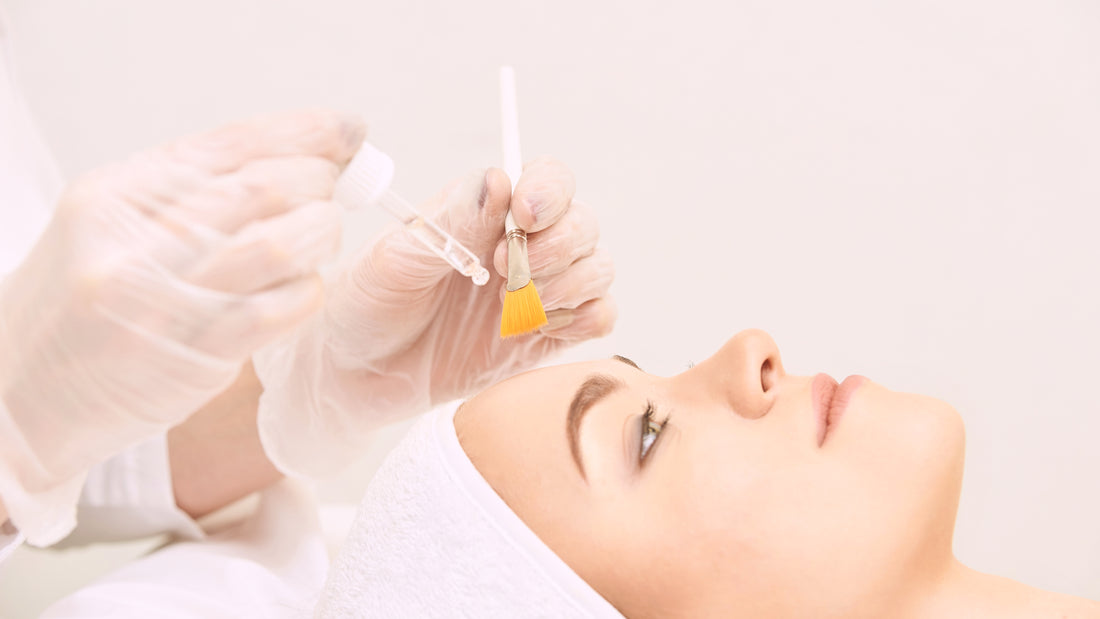
Misconceptions About Chemical Peels: What Actually Are They?
When you think of a chemical peel, you probably think of the 90s, when the treatment was extremely popular, or of some red-faced woman appalled that she has to attend an important event with an irritated face!
The chemical peels of today aren’t quite the same as those 20 or 30 years ago—but because of that, there’s a lot of misconceptions surrounding the treatment because people still think of the peels of old!
Here are six common misconceptions about chemical peels, as well as some additional information to help you decide whether a chemical peel is right for you!

First, what is a chemical peel?
A chemical peel is a combination of acids applied to the face in order to (gently!) remove a layer of skin and promote new collagen growth. It’s often used to reduce the appearance of fine lines, wrinkles, and acne scars.
This combination is made up of lactic acid, beta salicylic acid or glycolic acid, depending on your skin type. While the name chemical peel sounds scary, these acids are safe for skin and used in many facial treatments, including cleansers at the drugstore! The difference between a facial treatment at a spa and an OTC solution is the strength of the acid. Spa solutions will deliver a treatment with a higher percentage of these acids safely. At home treatments are great for the time in between visiting your favorite spa!
Misconception #1: Chemical peels are only used to remove precancerous marks
It’s true that chemical peels are sometimes used to help remove precancerous skin cells in patients who have marks on multiple parts of their face. These types of chemical peels are pretty intense because they are removing dangerous spots!
But lower-level chemical peels can be used for cosmetic purposes—to reduce fine lines, wrinkles, discoloration, and acne scars, as well as increase overall firmness and elasticity.
Misconception #2: Chemical peels are dangerous
Just the word “chemical” often makes people wary to receive a chemical peel. But when they’re performed by a licensed aesthetician or medical provider and are administered properly, they are actually very safe. The acid used in the prodeduce is used in small doses and is quickly removed from your skin in order to get the desired effects without any danger.
Misconception #3: Chemical peels will make your skin red and irritated
This is probably the most common misconception about chemical peels! While a peel that’s mis-administered or too strong can irritate your skin and leave you with sensitive, bright red skin, a typical peel should leave your skin feeling just fine! In fact, many peels can be administered in under 30 minutes, and you can go right back to whatever you were doing. While temporary redness is a possible side effect, if you experience redness for longer than 24-48 hours, you should contact your skincare provider.
Misconception #4: Chemical peels aren’t for certain skin types
Many people think that those with rosacea or a darker complexion aren’t candidates for chemical peels. But as long as you bring up any skin concerns with your aesthetician before your appointment, they’ll be able to administer a peel that is right for you. Certain types of peels have a higher risk of hyperpigmentation in people with darker skin tones, but that can easily be avoided. There are also specific peels that are designed specifically to treat sensitive or darker skin types, such as PCA’s Sensi Peel.
Misconception #5: Chemical peels require a lot of downtime
After a chemical peel, you won’t need to be holed up in your home for days on end waiting for your skin to heal. Most times, you can go right back to work or whatever you were doing with no downtime.
However, you do need to limit your sun exposure. Wear a broad-spectrum SPF face moisturizer and avoid going out into direct sunlight for extended periods of time.
Misconception #6: All chemical peels are the same
Not all chemical peels are created equal! Here at Skin Spa New York, we have to primary peels that we offer:
- Power peel — Choice of Lactic, Glycolic or Beta-Salycilic our power peels can reduce fine lines and wrinkles, treat acneic skin and more!
- PCA peel — a plethora of advanced corrective peels that rejuvenate skin and restore a youthful glow, corrects pigmentation and more. These TCA peels can be customized to target your specific needs.
If you’re unsure about which peel is right for you, virtually chat with an aesthetician to find out what is best to address your specific skin concerns! Schedule a virtual consultation today!
